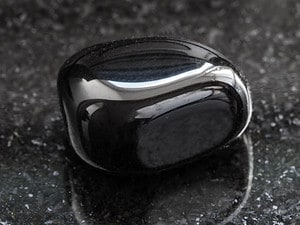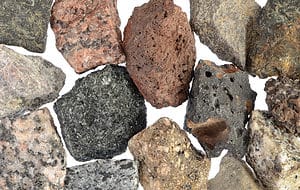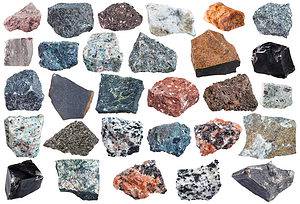Rocks are classified into three types: igneous, sedimentary, and metamorphic. We briefly summarize the differences, then focus on intrusive igneous rocks. We cover the commercial uses of each type of rock, alongside descriptions and photos.
Three Rock Types
Geologists classify rocks in three main groups:
- Igneous – rocks that form from cooling volcanic material. Examples include granite and peridotite.
- Sedimentary – rocks that form from eroded grains of other rocks and/or from organic matter. Sandstone and shale are two kinds of sedimentary rock.
- Metamorphic – rocks that form when one of the other two types is reheated and cools again in a different form. Marble and quartzite are both classified as metamorphic rocks.
Roughly 90-95% of the Earth’s crust is made of igneous and metamorphic rocks. Sedimentary rocks make up only 5-10% of the planetary crust. This doesn’t make them rare, though. In fact, the rarest and commercially most valuable rocks are igneous and metamorphic.

Most rocks are igneous or metamorphic, forming under heat and pressure deep below the Earth’s surface.
©iStock.com/Rost-9D
Classifications of Igneous Rocks
Based on Conditions of Formation
One way geologists classify igneous rocks is based on how they form.
- Extrusive igneous rocks form from volcanic lava cooling on the surface of the earth. Pumice and obsidian are good examples.
- Intrusive igneous rocks form when magma cools inside the earth, often slowly and forming large crystals. Diorite and granite are intrusive igneous rocks.
Intrusive igneous rocks can also be called “plutonic rocks,” a name referencing Pluto, the Greek god of the underworld.

Intrusive igneous rocks and the underground bodies where they form can both be called “plutonic.”
©VectorMine/Shutterstock.com
Based on Mineral Composition
Geologists also classify igneous rocks into one of four groups based on their mineral composition:
- Felsic – rocks that are high in light-colored materials such as quartz and feldspar. Granite is a felsic rock.
- Intermediate – in these rocks, quartz makes up 5-20% of the rock. Quartz syenite and quartz monzonite are two examples of these kinds of rocks.
- Mafic – rocks that are high in magnesium and iron, giving them a dark color. For example, basalt.
- Ultramafic – rocks made almost completely of olivine and pyroxene and having very little silica. Peridotite is an example of an ultramafic intrusive igneous rock.
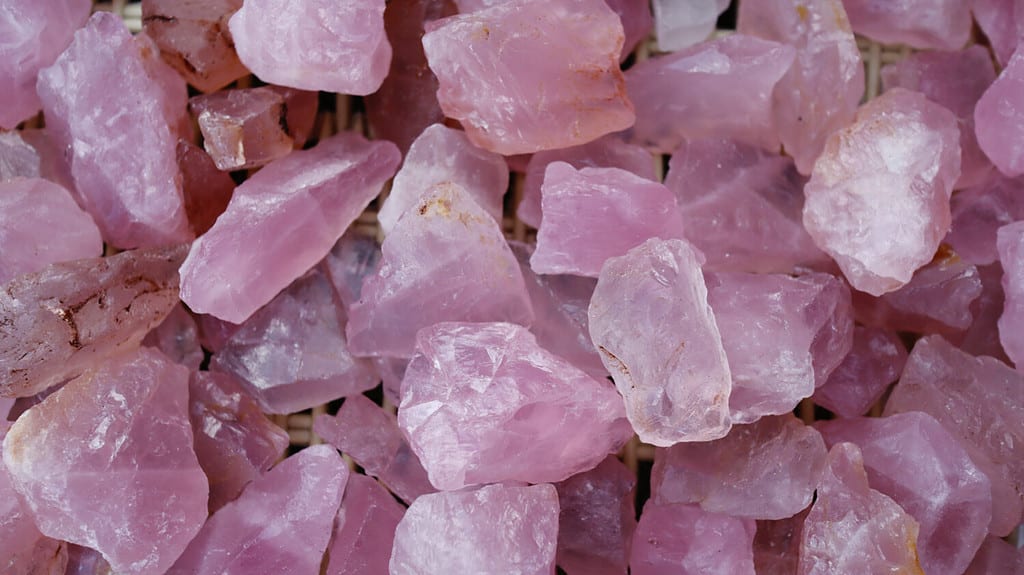
The percentage of quartz in a rock sample helps geologists classify it. This is an example of rose quartz.
©Pranisa Thanatattanon/Shutterstock.com
Examples of Intrusive Igneous Rocks
Here are a few examples of intrusive igneous rocks, along with their commercial uses.
1. Diorite
Diorite is a black-and-white rock with moderate levels of silica and a low alkali metal content. It has the same mineral composition as andesite but forms in different conditions. It’s often found at the base of mountain ranges at the edges of continents in places like Scotland and Norway. Ancient cultures in Mesopotamia and used diorite as a decorative stone, a building stone, and for carving sculptures. Later, in northern Europe, diorite was a popular choice for building durable cobblestone streets. Today, it is not used in construction as much as granite is, but you’ll still see it sometimes used as an aggregate stone, for street curbing, and as facing stones on a building.

Diorite was once a popular material in cobblestone streets.
©Shutter Wolf/Shutterstock.com
2. Gabbro
Gabbro is a mafic intrusive igneous rock. it is rich in calcium, magnesium, and iron but has little silica. It can also have minor amounts of hornblende, olivine, and other minerals that affect its appearance. It has the same composition as basalt, but because it takes longer to cool, gabbro forms larger crystals and a coarse grain. Gabbro itself is not popular as a construction material, as it is more difficult than comparable rocks to work with. However, gabbro deposits often have commercially viable amounts of desirable metals like gold, platinum, silver, copper, cobald, chromium, and nickel.
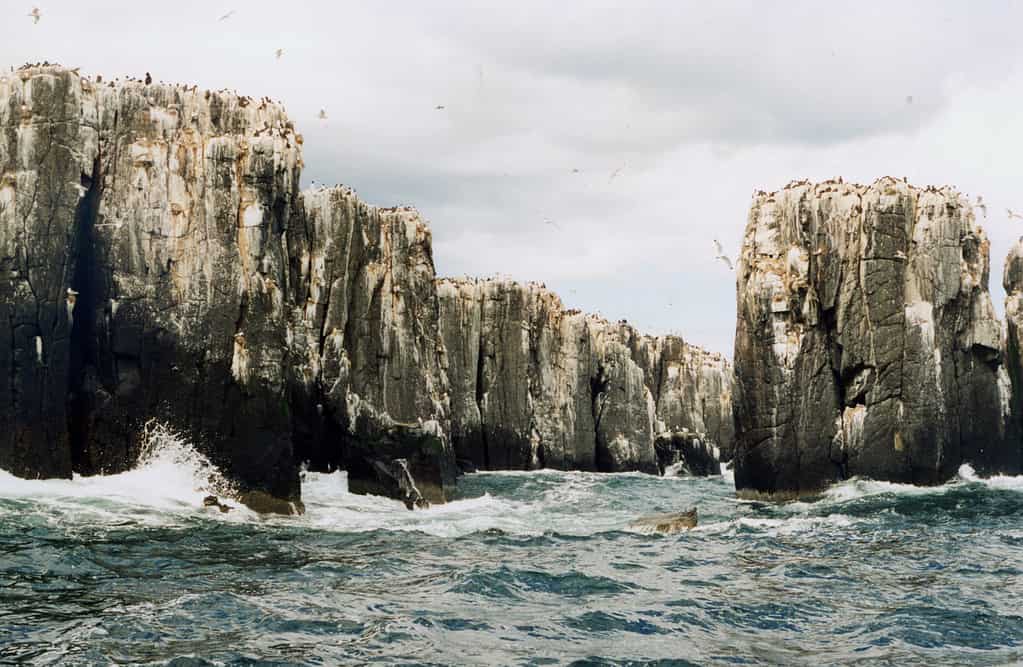
The Farne Islands are composed of towering quartz dolerite and quartz micro gabbros igneous rock.
3. Granite
Granite forms under the earth’s surface as magma cools. Because the cooling process takes place slowly, the rock has time to form large crystals that you can easily see with the naked eye. It’s made of hornblende, mica, quartz, and feldspar. Granite is a desirable building material because of its durability and variety of beautiful colors and patterns. Some of its uses are for flooring, wall cladding, monuments, and kitchen countertops. Granite makes a sanitary, low-bacterial surface that is durable, beautiful, and easy to clean.

Granite is a popular stone for kitchen countertops.
©StudioDin/Shutterstock.com
4. Peridotite
Peridotite is an ultra-mafic intrusive rock that has a coarse grain and a high olivine content. It has low levels of feldspar or silica. Peridotite has a much greater density than most other types of rock. It comes from the upper mantle of the Earth and is a common rock making up the sea floor. Peridotite is often colored with attractive shades of green and yellow. It is unstable outside the mantle, though, so as it weathers on the surface it can appear blue, brown, or red. Peridotite can be used as a gemstone for jewelry, in sculptures and artwork, as facing for a building, or as a garden decoration.
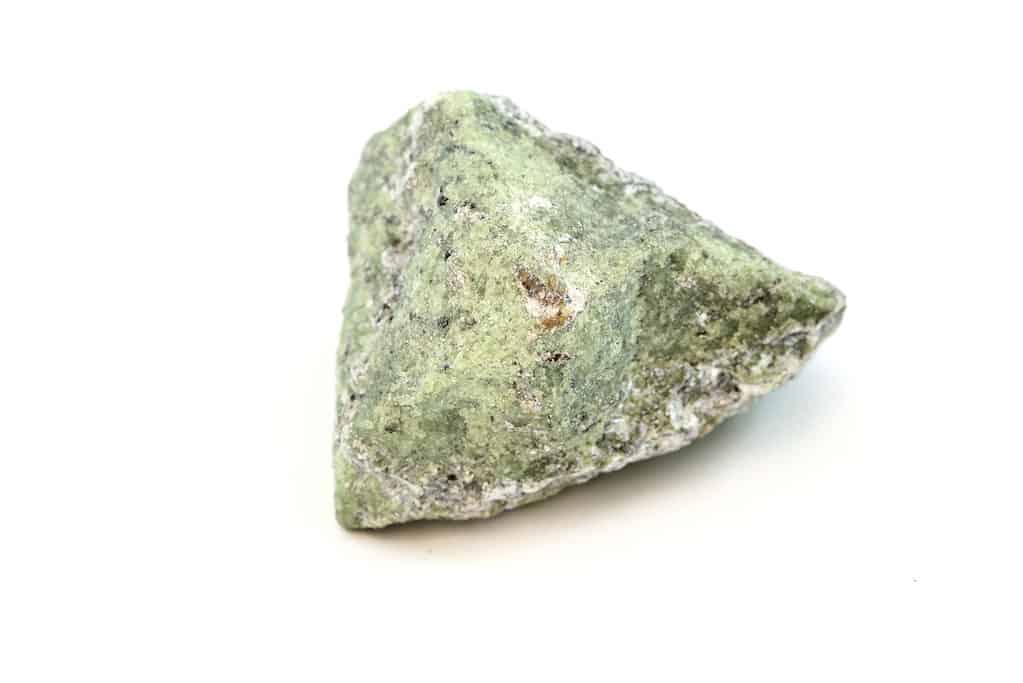
The gorgeous colors of peridotite make it a nice gemstone.
©Tyler Boyes/Shutterstock.com
5. Syenite
Syenite is a coarse-grained rock made mostly of alkali feldspar (the lighter part of the rock) and ferromagnesian materials like hornblende (the dark spots). Its composition is similar to granite but unlike granite, it does not include quartz. Syenite is classified as a rock of intermediate composition. Syenite is not a rare rock, but not particularly widespread, either. In areas where it is available, builders use it for flooring, as building stone or facing stone, as cemetery markers, and in the production of cement.

Syenite forms along subduction zones, where one tectonic plate is moving underneath another.
©KrimKate/Shutterstock.com
Are Igneous Rocks a Finite Resource?
As humans, it’s important that we find sustainable means of production, without depleting the planet’s resources. New igneous rocks are forming all the time as magma rises toward the surface and cools in underground chambers. So, whatever we use will conceivably be replaced through natural processes. At the same time, mining operations can rapidly work through rare materials that cannot be replaced as fast as we use them. However, if we develop the technology to mine asteroids and other planets, we will likely find all the materials we could ever need as an advancing, spacefaring civilization – including igneous rocks.
The photo featured at the top of this post is © Tyler Boyes/Shutterstock.com
Thank you for reading! Have some feedback for us? Contact the AZ Animals editorial team.




